Search Results for: the wall
Genre: Sci-Fi
Premise: An interplanetary explorer and a little girl crash land on earth 65 million years ago and must make it to their escape ship while avoiding the most dangerous predators the planet has ever known.
About: 65 inched its way towards a 13 million dollar opening this weekend, landing in third place behind Scream 7 and Creed 3. The subpar showing means we’ll probably never get the sequel, 66. Although, now that I think about it, that probably wouldn’t be a very good movie. Movie Trailer Voice Guy: “In a worrrllld consumed by fire and ash, where not a single living thing is still alive, one microbe is determined to replicate… in an attempt to repopulate the planet.” Yeah, probably won’t be at that one opening day. 65 was written by Scott Beck and Bryan Woods, who burst onto the scene several years ago with their breakout screenplay, A Quiet Place. This is their directing debut. The two first-timers had only 40 days to shoot the movie! For reference, Jurassic World had 115 days.
Writers: Scott Beck and Bryan Woods
Details: 93 minutes
 Is there anyone who looks more like a movie star today than Adam Driver?
Is there anyone who looks more like a movie star today than Adam Driver?
You may be thinking I’m covering the third biggest story today (Scream 7 and The Oscars being 1 & 2) but everything about this project, this screenplay, this movie, is infinitely more interesting to me than Scream or the Oscars.
Scott Beck and Bryan Woods wrote the spec script, A Quiet Place, five years ago. How cool is it that the script you’re working on RIGHT NOW could be the next Quiet Place. And how cool is it that several years later you could be directing a movie with freaking dinosaurs in it?? I just think that’s the awesomest thing in the world. It definitively shows you the power of a great script.
If I were still writing screenplays, this is the type of script I would write. A huge concept with a simple story – the kind of thing that works both on the page and in the theater. At least, theoretically. Maybe I’m about to learn my latest screenwriting lesson after watching “65.”
65 follows an interplanetary explorer (from another planet – not earth) named Mills. Mills is dealing with a daughter who grows very ill and then dies. But work calls so he has to get out there and keep sussing out the universe.
Halfway through his latest trip, an undocumented meteor cluster hits the ship and he crash-lands on earth…. 65 million years ago. Everyone in the cryo-bays is dead except for a 10 year old girl named Koa. Unfortunately, Koa speaks another language, so her and Mills can’t understand each other.
Mills realizes that when their ship broke up, the escape pod landed about 10 miles away on the side of a hill. And it’s still in tact. So if they can get to that, they can pop back up into space and wait for a rescue vessel.
But it’s not going to be an easy trip. Cause it’s 65 million years ago when dinosaurs were at their hungriest. Right away, Mills is attacked by a little baby runt lizard thing that’s as big as a large dog. He barely survives. And that’s one of the weakest animals he’ll to have to deal with!
As they traverse the jungle and try and communicate with each other (poorly), Koa spots something in the sky casually zipping past the moon. (Spoiler) Later, Mills sees it too, and we’re introduced to the coolest plot development in the movie – that the anomaly is the meteor that wipes out the dinosaurs. Yes, our duo happened to arrive on earth just hours before the most devastating moment in the planet’s history. Talk about bad timing.
Now, getting to the escape pod takes on significantly more importance. But, along the way, our duo gets the attention of a couple of T-Rexes. Unknown to Mills, the T-Rexes stalk them from a distance to the escape pod where they perform an all-out attack on our heroes, determined to keep them here and make them suffer the same fate as them.
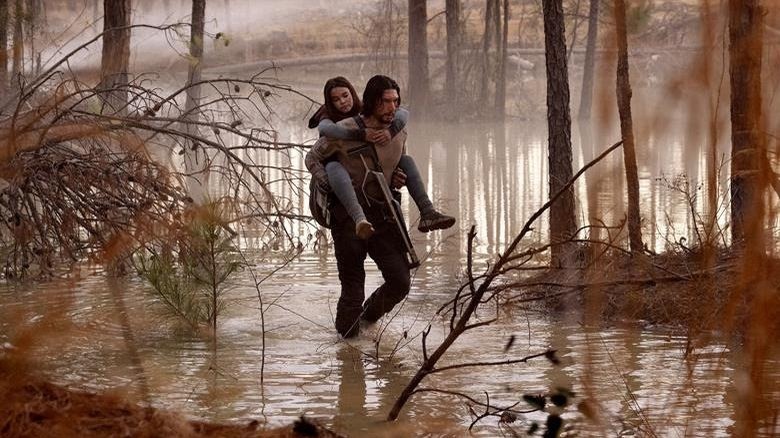
Probably the hardest thing to do in a script like this is come up with two characters who we actually care enough about that we want to spend an entire 100 minutes with them.
Beck and Woods do all the right *technical* things in this screenplay. They give Mills a traumatic backstory where his daughter died of an illness. That’s what we’re told to do as screenwriters. If we want to build sympathy towards our protagonist, create a sympathetic situation for them. What’s more sympathetic than a parent losing a child?
Then you have the girl. This is a helpless little girl who’s scared and who only cares about getting back to her family. Who’s more sympathetic than a helpless scared girl?
Beck and Woods also incorporate a screenwriting tip I routinely encourage, which is to make things difficult for your characters. You never want anything to be easy for them. So B&W make it so Koa speaks another language. This creates a language barrier. Now it’s difficult for Mills and Koa to communicate even basic things, which makes their task of working together that much more difficult.
So far, no mistakes have been made in this screenplay.
Then you have the most ruthless landscape in history. Literally every inch of the 10 miles you’re going to traverse has potential danger within it. This creates tons of tension and suspense, which is exactly what you want in a movie like this.
Finally, Beck and Woods create one of the coolest ticking time bombs I’ve ever seen in a movie: THE meteor that killed the dinosaurs. I had a huge smile on my face when that plot point was introduced. And I gave the writers extra credit because they combo’d the inciting incident (the crash) with that meteor’s orbiting rocks, setting up the meteor from the get go. This makes the meteor’s arrival feel believable as opposed to forced.
All that should add up to a great movie, right?
Yes.
But it didn’t.
Why?
I had to sit with this one for a while because I didn’t know the answer to that question right away.
All I know is that the movie had some cool moments for sure. But I wasn’t engaged the way I wanted to be. Something was missing. And I tried to figure out what it was.
The first thing you look at is the main characters. There is an enormous importance to the audience liking the characters in scripts like this because there are only two of them. There aren’t any other characters to cut to. So if we don’t love the main protagonist, and love the co-protagonist, as well as love both of them together, nothing else matters. Doesn’t matter if you have sixty gazillion dinosaurs. We’re going to be bored.
One of the mistakes Beck and Woods made was DKB. DKB (Dead Kid Backstory) is a cancer upon screenplays. It is the single laziest attempt to create sympathy the screenwriter has access to and, therefore, often creates the opposite effect of what the writer is going for. Especially if you do what Beck and Woods did here, which was to endlessly repeat DKB. We must have seen Mills’s dead kid a thousand times throughout the movie (in videos and flashbacks) despite the fact that she’s dead!
Dead Kid Backstory can work if the movie doesn’t depend on it. Gravity is a good example. We never once see Sandra Bullock’s dead kid. But that backstory was enough to motivate the character (in that she wanted to get away from earth) and that’s all we needed. I suppose there are a handful of examples of DKB working but that’s a handful out of thousands of attempts. It’s just lazy.
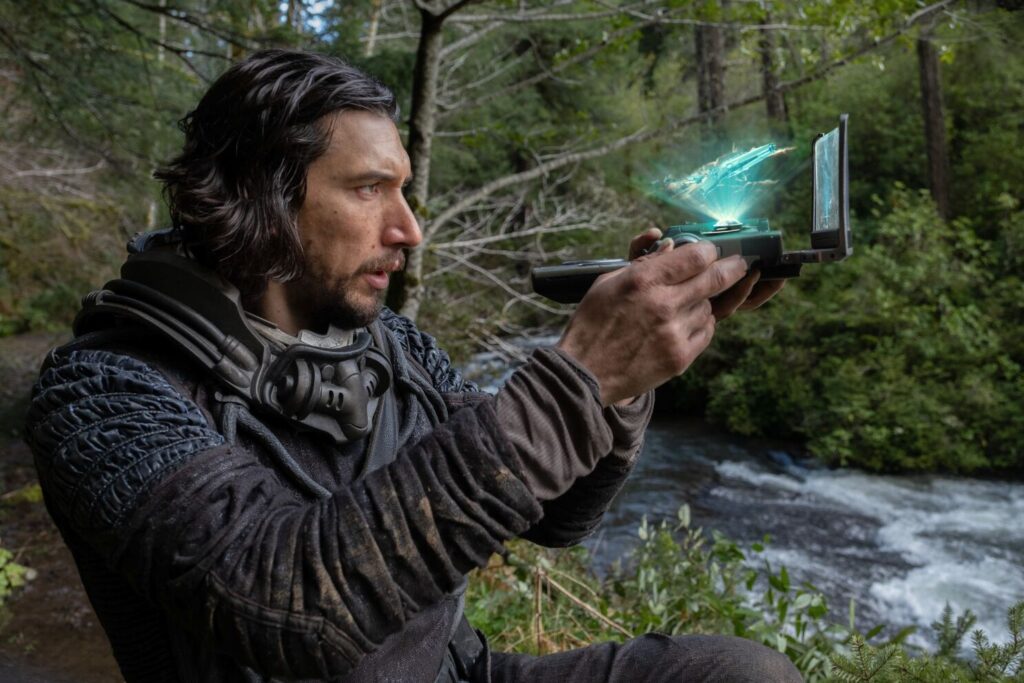
The other big mistake they made was having Koa speak a different language. I think I know why Beck and Woods did this. A lot of these adult-kid team-ups inadvertently descend into the kid being the “adult in the room.” They’re smart. They’re precocious. And it just ends up feeling false, with the kid snapping back at our hero in ways that would never happen in reality. By creating this language barrier, there was no way the script would fall into this trap.
But in a movie with just two characters and those characters can’t have any real conversations? You’re playing with fire. That’s a long time to ask the audience to spend with characters without a single extended conversation. People get restless. Even in Beck and Woods semi silent film, A Quiet Place, there were full conversations that were had.
This is where writers can sometimes get ahead of their skis. They want to make some profound silent film. But silent films are freaking hard to pull off. Audiences don’t have the patience – especially these days – unless you execute a perfect 10 on the dive. Mixing metaphors here – roll with me.
The thing that ultimately did the script in was there wasn’t enough variety. This is a challenge you’re always going to run into in a script like this. 90% of the scenes are walking through a forest with dinosaurs peeking around the corner. You need to find ways to mix it up. And the ways they mixed it up didn’t work. For example, they tired to have a cave scene. But it was sloppily constructed and not very clear. “Mixing it up” only works when the mixed up part is good. Duh but, yeah, that’s the reality.
Oh, and one other thing that hurt 65 was that a concept like this necessities a large scope. There’s a natural let down when that scope isn’t met. The reason a movie like Palm Trees and Power Lines, which also revolves around two characters, works, is because the expectations of the concept are low. It’s two people stuck in a small town. 65, however, is overwhelmed by its gigantic premise, which eventually swallows it up. The audience wants more than the movie can give them.
I’m bummed out. Because the movie wasn’t bad. It just wasn’t as good as I wanted it to be. And I’m going to cheat here with the rating because while there is no way this movie is worth the 20 bucks it costs to see in a theater, I do think it’s a strong streaming choice where the expectations are lower. And I have to support spec scripts and original material. We need more shots like this or else we’re going to be stuck with “The Creed Universe.” Dear lord help us all.
[ ] What the hell did I just watch?
[ ] wasn’t for me
[x] worth the stream
[ ] impressive
[ ] genius
What I learned: There is no other artistic medium that thrives in the present better than the movie. Movies are the most alive when they’re focusing on the RIGHT NOW. Therefore, when you put too much emphasis on things that happened in the past, you move away from what makes a movie work. That’s not to say you should never include the past in your scripts. The past informs who your characters are in the present. But if you’re going to go down that road, know that you are purposefully moving away from what makes a movie work. Therefore, you better have a great reason for it.
What I learned 2: One way to fend off repetitive storylines is to add more twists than the average screenplay. Add more shocking moments. 65 could’ve benefited from a couple more of those for sure.
Genre: Satire/Comedy
Premise: Shunned by elite society as a member of the gig economy, a sociopathic dog walker infiltrates an exclusive L.A. community with designs of reaching the top of the neighborhood’s social ladder.
About: This script finished in the top 10 of last year’s Black List with 20 votes. This appears to be the brothers’ first big screenplay.
Writers: Briggs and Wes Watkins
Details: 100 pages
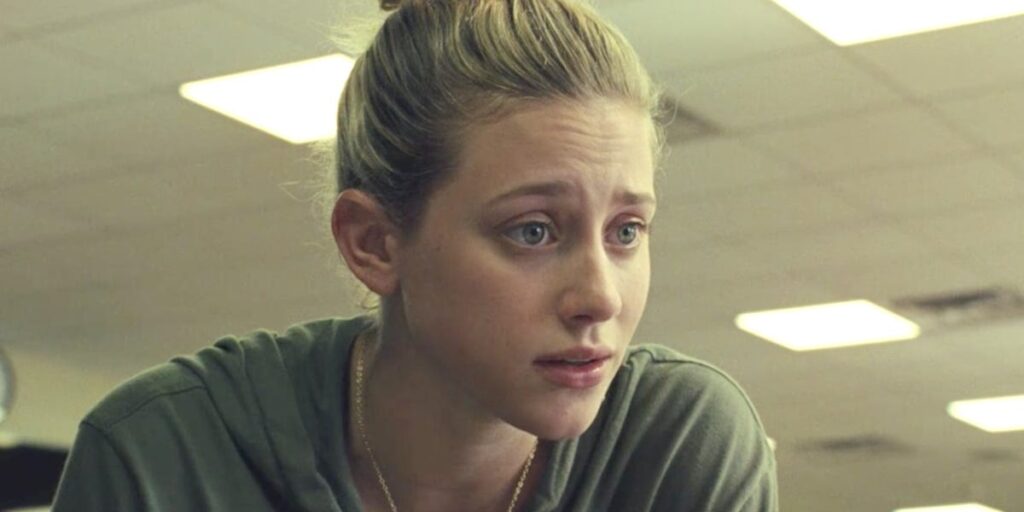 Lili Reinhart for Dylan?
Lili Reinhart for Dylan?
A few people told me this wasn’t very good. But it does come from a sub-genre that I like. So we’ll see what happens. Oh yeah, a quick note. This script has a lot of twists and turns. It is best enjoyed reading it yourself rather than reading my synopsis. Because my synopsis WILL reveal spoilers.
24 year old Dylan is squatting in a Hollywood apartment, not doing anything with her life that I could discern other than her hobby of sneaking into rich peoples’ houses and pretending that she lives there until the owners come home and she has to sneak out.
One night, while hanging out in a Beachwood house, a dog-walker comes in and catches her there. The dog-walker doesn’t report her though. Instead, she tells Dylan that if she wants to sneak into peoples’ houses, she should walk dogs.
This is a lightbulb moment for Dylan, who immediately visits a dog park the next day and notices a beautiful woman named Jessica walking an even more beautiful dog. Jessica’s dog is the clear star of this dog park and so Dylan tries to befriend her to see if she can work for her.
When Jessica blows her off, Dylan follows her up to a Griffith Park hill trail, kills her, then kicks her dead body over the cliff. She takes the dog, heads back to the owners home, and informs the couple living there, Shira and Jacob, that Jessica has moved on and she will now be walking the dog.
Dylan does this for a while until the dog attacks and nearly kills another dog who happens to be walked by… the very girl who caught her in the first house and told her about this whole dog-walking gig. Dylan makes a run for it but eventually, our initial dog-walker, whose name is Anna, finds her.
She makes casual chit-chat with Dylan BEFORE KILLING HER!!! That’s right. Another murder. Who wrote this? Bing ChatGPT? And we’re only on page 45! With Dylan now dead, we start following Anna, who wants to do what Dylan was doing who wanted to do what Jessica was doing.
Anna makes friends with some other dog-walkers but when they suspect that she may have some information on the death of Jessica, she goes into self-preservation mode. She then makes a bold move, blackmailing Shira and Jacob, knowing that if they don’t consider her dangerous, she’s done. Will Anna’s plan work? Or will she end up like her predecessors?
In the words of the great Iggy Pop, “I’m a real wild one. And I like a wild fun. In a world gone crazy. Everything seems hazy. I’m a wild one. Oh yeah, I’m a wild one.”
This was a wild one, folks.
I’m still not even sure what I read. But I wouldn’t call it un-entertaining. Maybe uneven.
Whenever you’re trying to write sophisticated satire – which I’m pretty sure is what this script is – you have to be smarter than everyone in the room. There can’t be any clunky moments or frayed edges. We really have to feel, as the reader, that you are in total command of this commentary.
I didn’t feel that way. It started with the opening page.
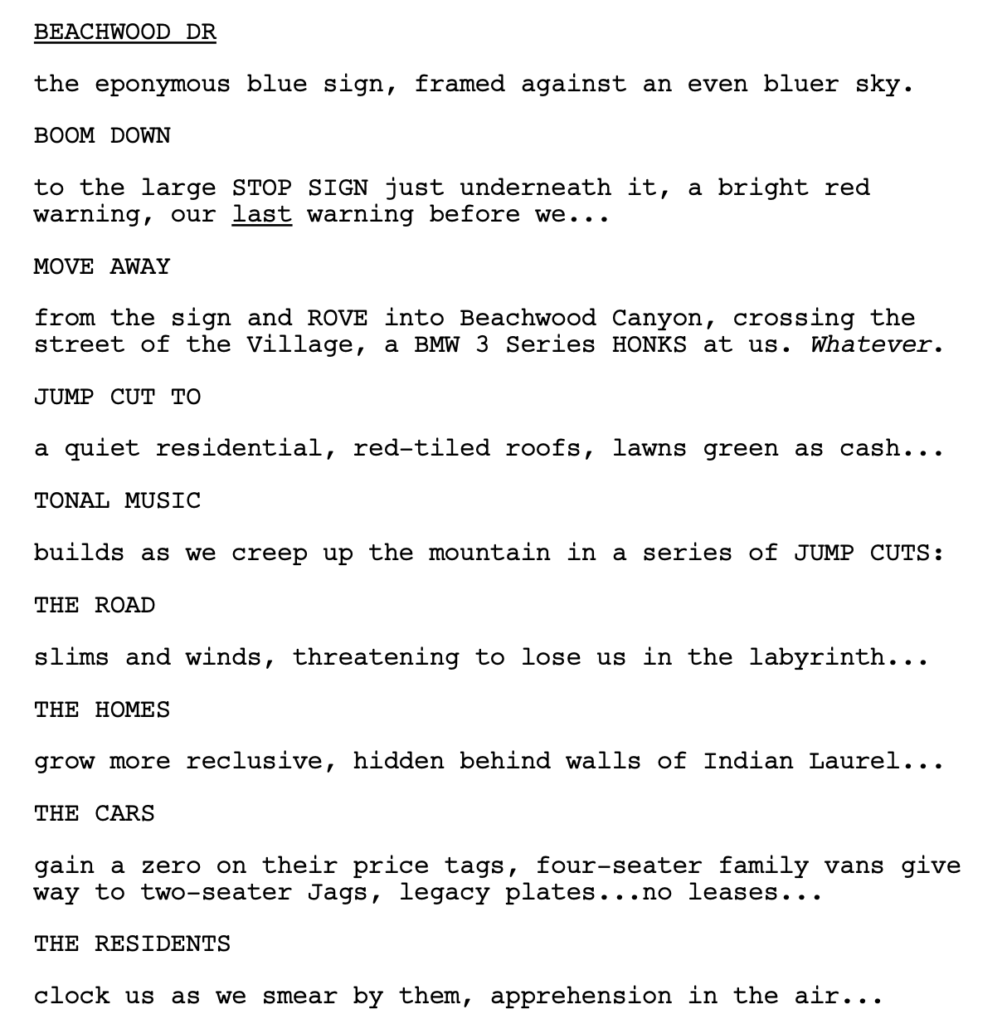
The “whatever” is unnecessary. “Green as cash” is not a great visual simile. The road “slims and winds.” “Slims” is an awkward word to use there. Hidden behind walls of “Indian Laurel.” I don’t know what that means. Is there a famous Indian girl named Laurel who’s cloned herself and stands outside every house in Beachwood? “Gain a zero on their price tags” is an, arguably, try-hard line. “As we smear by them” is a strange description. I have to strain to imagine it.
I’m probably being too hard on this page but it definitely prioritizes style over clarity and that’s something I never endorse. Clarity must always come first in screenwriting. So, right from the start, I was wary.
Another problem is that I could never figure Dylan out. Since her whole life was a lie, I didn’t have anything to grab onto, relate to, or care about. There was so much distance between me and her that I never felt close enough to her story.
Why is she doing this? Where did this compulsion come from? Why is she squatting around in Hollywood and sneaking into peoples’ houses? We don’t know. We’re asked to buy that at face value and that’s not how storytelling works. We have to know why humans are doing the things they’re doing in order to become invested and interested.
A good example is the movie, Emily The Criminal. In that screenplay, the writer makes sure to take us through Emily’s struggles of trying to get a job, subsequently working a job she hates. So that when she’s given this opportunity to make money by stealing, we know why she’s doing it.
Meanwhile, I barely know Dylan and, out of nowhere, she kills this dog-walker and kicks her off a cliff and I’m just supposed to go with it?
Of course, I eventually realized why this was the case. Dylan wasn’t written to make it through the story. She gets killed. Which was a huge shock. But it would’ve resonated more had we felt some attachment to her.
To the Watkins credit, there’s some fun stuff going on here with the way the characters feed into the story. We meet this random dog-walker in that opening scene – the one who catches Dylan in the home, then we forget about her. Only to meet her again, 50 pages later, and then she becomes the main character.
Dylan also meets this character named Noah in the dog park early on the story. He disappears. But then, when Anna takes the lead role in the story, she meets Noah as well and also befriends him. So it was cool how these characters were woven into this weird tapestry of a screenplay.
But I just don’t know what to make of this thing. There are so many creative choices that make you go, “hmmmmm….” There’s an entire scene dedicated to expressing a dog’s anal glands in front of a small audience that felt more like it belonged in a 1998 Farrelly Brothers movie than in this sophisticated satire.
And then there are only really short dialogue scenes the whole movie before 80 pages in where we get this gigantic six page dialogue scene that comes out nowhere. Some of you might not think that’s a big deal. But screenplays have a rhythm. And if you establish that rhythm only to completely upend it, it’s jarring. The reader isn’t sure what to make of it.
However, I will say this. This script is the most unpredictable script in the Top 10 of last year’s Black List. It’s weird. It’s kinda fun. Even though it has problems, it does leave an impression on you. For those reasons, I think it’s worth reading.
[ ] What the hell did I just read?
[ ] wasn’t for me
[x] worth the read
[ ] impressive
[ ] genius
What I learned: I like when writers keep their character in a state of desperation. It forces the character to constantly act and solve problems, which often results in interesting dramatic situations. Just as Dylan gets the dog-walking job with Jacob and Shira, she gets kicked out of the apartment she’s squatting at. So now she doesn’t have any place to live. This places a question in the reader’s mind – What is she going to do now? – that compels them to keep reading to find out the answer. If she never would’ve gotten kicked out, that’s one less reason to care what happens next.
Genre: Comedy
Premise: When his girlfriend catches her boyfriend doing something unthinkable, she leaves him, forcing him to consider the unthinkable – therapy.
About: This script finished top 10 on the most recent Black List. Shane Mack has one produced movie under his belt in 2020’s Coffee and Kareem, which was on Netflix and starred The Office’s, Ed Helms.
Writer: Shane Mack
Details: 118 pages!
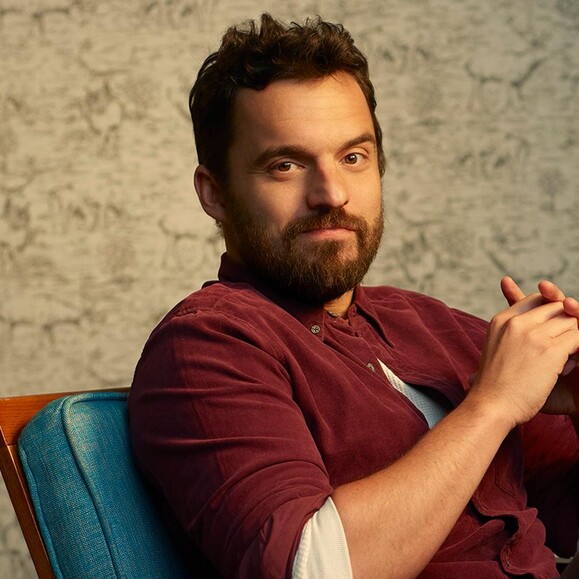 Jake Johnson for Guy?
Jake Johnson for Guy?
Sometimes you look at a logline and you think, “How in the world is that a movie?”
I’d definitely put A Guy Goes To Therapy in that category.
I mean, it’s right there in the title. “A guy goes to therapy.” Annnnnnd……???
Then what?
I guess we’re about to find out!
Guy is 36 years old and a construction worker. He’s creeping into middle age having not reached his potential in life. But the one good thing he has going for him is his girlfriend, Jen. That is until Jen, while checking her “cat cam” from work, inadvertently sees Guy eating the entire shaker of parmesan cheese.
The image is so odd and so distributing that it triggers a series of emotions that lead Jen to dump Guy. Guy is baffled. Who gets dumped for loving parmesan cheese too much? Of course, what Guy doesn’t yet know is that the cheese is symbolic of much bigger issues in his life, namely that he’s a man-child.
When Jen suggests that Guy go to therapy and figure his s—t out, he’s offended. He’s a man! He doesn’t need therapy! Guy tries to find his own version of therapy with his group of immature friends, but they’d rather argue about which of them can beat up the Avengers than what Guy needs to do to become happy.
So Guy bites the bullet and goes to therapy but therapy turns out to be just as much of a tug-of-war as talking to Jen. This therapist doesn’t get it! At least that’s Guy’s assessment of the situation. Guy then does what all broken-hearted people do, which is stalk his ex-girlfriend’s house, where he finds out she’s banging some short guy.
Guy becomes obsessed with Short Guy and secretly follows him to the gym, only to discover in the changing room that Short Guy has a 13 inch penis. This 13 inch penis may get its own spinoff film at some point because it is honestly the biggest plot point in the whole movie, no pun intended.
Guy keeps going to therapy in the meantime and, after he lowers all his walls, actually starts making progress. But will he make enough progress to get Jen back? Will he even want her back at that point?
Okay, let’s talk about script length for a second.
We’ve debated script length ad nauseam here, coming to the conclusion that how long your script should be depends on a number of factors.
However, one thing I can tell you for sure is that a comedy called, “A Guy Goes to Therapy,” should never, in a million years, be 118 pages. At most, it should be 110 pages. And, ideally, like most comedies, it should be 105.
When I see an incorrect page length, my spider senses start tingling. I’m on high alert. And when I then read a 4 page scene where characters debate which Avengers they could beat up, the writer has just confirmed my biggest fear. Which is that there are probably going to be a lot of scenes in this script that don’t move the story forward. Sure enough, that’s what we get. A lot of 2023 versions of Kevin Smith scenes, where characters debate penis size for 5 pages at a time.
Once I understood what kind of script this was, though, I was able to change my mindset slightly and attempt to enjoy it for what it was. I’d categorize it as an Anti-Judd-Apatow comedy. It has a lot of guys hanging out talking about women and life, but the tone is more cutting and less fun.
And I think that’s where the script lost me. Guy is angry, he yells at everyone, he doesn’t think anything’s his fault. And while Apatow’s characters are similarly flawed, Apatow knows that, in the end, the audience has to like the guy. It’s a comedy. We need to like the hero!
I hated Guy. He’s petulant. He’s juvenile. He’s judgmental. He’s selfish. This is impossible to get away with in a comedy. It’s just impossible.
You’re probably saying, “Well, he has to be flawed if you’re going to build a movie around him going to therapy.” Yeah but, if we hate the character, we don’t care if therapy helps him or not. Which is how I felt. I was rooting way more for the therapist to get through to this moron than I was Guy.
When you write a script like this these days – something heavy on dialogue and light on plot – you need a strong theme. Cause something needs to stand-in for the lack of story going on. At times, it felt like the script had this. There were these moments that commented on masculinity in the modern age.
For example, Guy picks up a girl at the bar who, it turns out, is only sleeping with him because she feels sorry for all the men on the planet who are being emasculated by modern social conditioning.
But as soon as these mini-commentaries are made, they disappear, and it’s a while before we get another one. It was too inconsistent of a commentary for me to count it as an official theme. If this script made a bigger commitment to that theme, I probably would’ve liked it more. Cause it would’ve felt like there was a point to the movie.
However, I fear that the problems go much deeper for Guy Goes to Therapy. You guys all know my concept rule by now. If the main plot is something that can be a subplot in another movie, your concept probably isn’t big enough. I see therapy subplots all the time in movies. And I don’t think they’re big enough to take center stage.
I realize there’s a little leeway to that rule when you’re dealing with a comedy. But this script didn’t convince me that it was the exception. There were too many scenes where we just drifted. Hanging out with friends, debating life. I need more momentum and purpose and stakes in my story.
As for the the good stuff, I thought the reason for the breakup was hilarious. Your girlfriend checking her cat-cam while at work only to find you eating parmesan cheese like trail-mix — in all the breakups I’ve read, I’ve never read one like that. Very funny.
I also thought the writer made an interesting choice by never showing the therapist, which has an interesting reveal. And I think that the writer has a strong voice. I wouldn’t say I was fan of that voice. But that’s what voice is. It’s polarizing. Just because I didn’t like it doesn’t mean it didn’t have power. I definitely remember the conversations in this script and that’s because the voice on display was so big.
I suspect that if you’re in your 20s and like comedies, you might connect with this. But this script just wasn’t for me man.
[ ] What the hell did I just read?
[x] just wasn’t for me man
[ ] worth the read
[ ] impressive
[ ] genius
What I learned: If you’re writing something that’s exclusively dialogue-driven these days, it doesn’t make a lot of sense to write a feature film. You’re much better off writing it as a pilot. TV is about characters talking to each other so if you have a script with a lot of characters doing a lot of talking to each other, write a show.
What I learned 2: Get rid of the fat (tighten the screws). A script should’t feel like it’s been written off-the-cuff. It can feel that way in a first draft. But, after that, it’s your job to tighten the screws on every scene. Get rid of all the excess dialogue. Even in scripts like this, where the dialogue is more fun-driven than plot-driven, there are always weaker jokes you can get rid of. If you keep everything in, it feels way too messy.
Genre: Superhero
Premise: After T’Challa’s death, an angry group of people at the bottom of the sea show up on Wakanda’s doorstep and demand an alliance to help defeat the rest of the planet.
About: After the death of the series’ star, Chadwick Boseman, the Black Panther franchise had to reset and construct a new path. After a long and agonizing production that had its fair share of victims (star Letitia Wright claimed, at one point, that she was done with the franchise), the film finally came out this weekend. The movie caps off Marvel’s controversial, “Phase 4,” which found itself taking more chances and putting a premium on diversity, which yielded mixed results. The film took in 180 million dollars over the weekend. The original film debuted with 200 million dollars.
Writers: Ryan Coogler and Joe Robert Cole
Details: 160 minutes!

Can you imagine making this movie?
Your star dies. A pandemic swoops in, handicapping your production. And your replacement star resists getting vaccinated, causing a complete upheaval on set. Oh yeah, and she later suffers a terrible injury, which further throws production into disarray.
I don’t believe in cursed movies. But if you’re going to make an argument for them, Wakanda Forever is Exhibit A. It reminded me a lot of what happened to the Matrix sequels. Those films were so devastating to those directors that they haven’t been the same people since.
But Hollywood has a long history of cursed productions that turned into great movies. Look no further than Titanic. The prevailing theory for a pro-drama production is that on-set conflict fuels an energy that seeps into the movie itself.
Let’s find out if that was the case with Wakanda Forever.
WK starts with T’Challa’s scientist sister, Shuri, frantically working through a computer computation to move the molecules around to save her sick brother, who we do not see. She fails and an elaborate Wakanda funeral follows.
As Shuri and her mother, Queen Ramonda, pick up the pieces after T’Challa’s death, they are visited by a spooky dude from the water with wings on his feet named, Namor. Namor tells Ramonda and Shuri that some American scientist is providing the U.S. with tech that’s allowing them to mine super-resource, vibranium, from their seabed. He wants them to kill this scientist.
So Shuri joins Wakanda’s new number 1 warrior, Okoye, and they head to Massachusetts where they find out this scientist is a college girl named Riri. Riri’s been working on her own personal Iron Man suit, which she’s able to bust out and play with as soon as the government gets wind of this meeting and attacks the three of them.
Our trio escapes, but are quickly captured by Namor and his sea people, who take Shuri and Riri down to the bottom of the ocean. There, Namor explains to Shuri that the Wakandans have to team up with his people and destroy the world because, um, the world is bad?
When Shuri and the Wakandans refuse, Namor kills the queen, making Shuri the new queen. Shuri finally accepts the burden of leading Wakanda, becomes the new Black Panther, and orders an attack on Namor for revenge. The two then battle to the death!
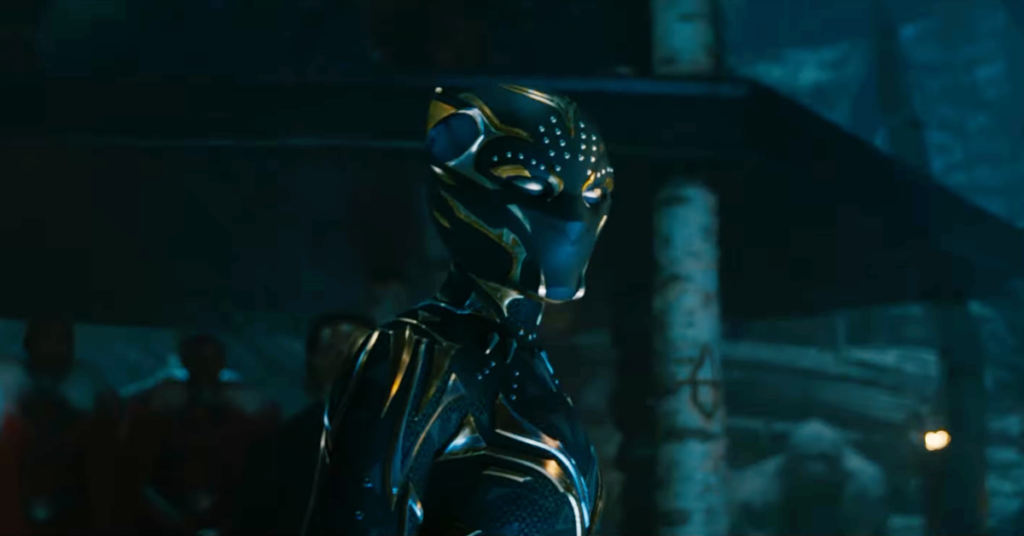
I absolutely loved the opening of this movie.
Well, first of all, I love Letitia Wright, the actress who plays Shuri. She’s unlike any actress out there. And I felt that she captured not just the fictional response to Black Panther’s death in this opening scene, but her own response to Chadwick’s death. It was so heartbreaking. And I teared up myself when the Marvel logo came up but instead of playing all the best moments from Marvel movies like the logo usually does, it played the best moments of T’Challa. It was probably the best creative choice of the movie.
But once the movie got going, it was clear that the screenwriters were lost in the woods as the entire narrative took on a ‘searching’ vibe. It was never quite sure what it wanted to be and, as a result, became a mixed bag.
Let’s start with the villains. The choice of villains felt totally random. Why ocean people? There isn’t any clear connection or irony in choosing these sea villains. The only thing I could come up with was that Namor’s folks were the only ones who could get into Wakanda, since they did so through the water.
Don’t get me wrong. The design of these people was cool. I just didn’t feel any organic connection between them and the Black Panther mythology.
From there, you have this double-whammy issue of no main character and no male characters. Through the first 100 minutes of the movie, I had no idea who the main character was. For those who don’t know, the main character in a screenplay is almost always the one driving the plot forward. They have a goal. And we follow them as they try and achieve that goal.
Here, we get this awkward mash-up of quarter-main-characters with Shuri, Okoye, Ramonda, and Riri. Audiences feel confused when they don’t have a main character to latch onto. They need that guidance. Even in Avengers, Iron Man was our main character. We always came back to him to pull the story together. This film lacked that.
And then, you had this strange lack of testosterone in the movie. While I know all-female casts are trendy these days, it seems like a major risk for a movie that’s supposed to be for everyone. To have no male protagonist joining the Wakandans?? You need that balance between the male and female and this most certainly lacked that.
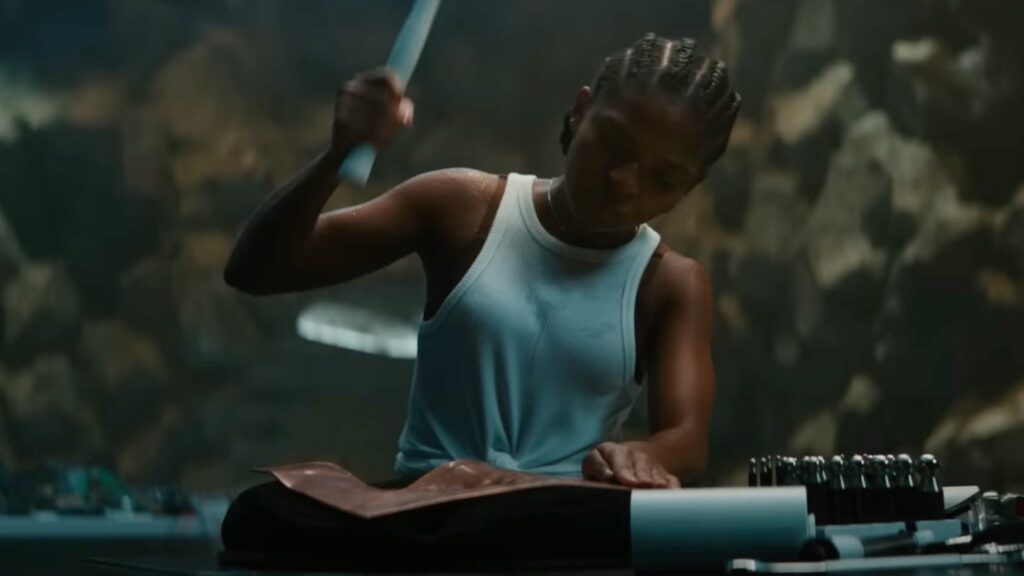
There was something else missing from the story and I kept struggling to figure out what it was until late. Coogler decided to make an origin story. This movie was Shuri’s origin story. Never in the history of trilogies have we ever had an origin story in the second film. Granted, these were extenuating circumstances, but still. If something felt odd to you, that was probably what it was.
And the thing is, they could’ve made it work. But they decided on a structural choice that kept the plot from succeeding, which was they waited all the way until the end to turn Shuri into Black Panther. That sounds great from a character arc perspective. But from an audience enjoyment perspective, it doesn’t work.
Look at The Matrix. Neo doesn’t fully turn into “The One” until the very end of the movie. But he still gets to do cool matrix-like stuff, such as fighting Agent Smith in the subway, or shooting up a bunch of swat dudes in a building lobby while flipping around, well before that happens.
Shuri does absolutely nothing before she becomes Black Panther. And that really hurt this film. Cause we were all looking for someone cool to latch onto. And we didn’t have it for the bulk of the movie.
On top of all this, the motivation is really weird in this film. “Motivation” is the starting point for any plot. Thanos is going to snap the universe in half – we need to stop him. That’s clear motivation.

The motivation here is all sorts of wonky. The U.S. or NATO (it’s unclear) are trying to steal vibranium from Namor’s people. So Namor comes to Wakanda and says, “you need to help us stop them.”
What???
So the main issue isn’t even Wakanda-related? It’s affecting some other group of people we didn’t even know about until this movie?? And they need our help to stop a third party??
What are we doing here?
I call these “one-step removed” motivations. They’re not direct. They require some connecting variable to make sense. And those are never as strong as direct motivations.
So when you combine a one-step removed motivation with no main characters with the oxymoron of a sequel origin story with a “No dudes allowed” sign with a hero who doesn’t do anything cool until the final act… it’s really hard to get a good movie out of that.
YET…. I almost recommended this. As I said, I really like Letitia Wright. So I enjoyed watching her whenever she was onscreen. I thought some of the bad guy moves – such as water bombs and siren songs – were kinda cool. I thought Okoye was a kick-butt fighter. I liked watching all her fight scenes. And while there were too many talking-heads scenes for my liking, I find Ryan Coogler to have a great feel for directing character-driven scenes. They always felt genuine to me.
The reason it doesn’t get a passing grade is Riri. Your movie is too long. Way too long. Yet you’re greenlighting the addition of a character who has nothing to do with the plot and who adds a good 20 minutes to the movie? That’s unacceptable.
How off was the addition of this character? Namor literally says, “I want to kill this girl.” That’s his whole motivation for the first half of the movie. Then, he has her IN HIS UNDERWATER PALACE and he doesn’t do anything to her!!!! He seems unaware that she’s even around.
Someone has to take a stand against this dumb Marvel directive of shoving unimportant characters into a movie in the hopes of building their awareness for separate franchises. Wakanda Forever could’ve been a really good movie. It could’ve been the most emotional movie of the entire franchise. But when you’re forced to rearrange plotlines, making them convoluted and hard to follow, in the process elongating your film to an annoying length, to include characters like Riri, who weren’t even likable mind you, you lose a lot of points for that.
Black Panther: Wakanda Forever has some shining moments. But its endless runtime and questionable plot choices keep the narrative from ever finding a satisfying pace. I would rank it somewhere in the middle of the pack of the 30 Marvel movies that have been produced so far.
[ ] What the hell did I just watch?
[x] wasn’t for me
[ ] worth the price of admission
[ ] impressive
[ ] genius
What I learned: The Reluctant Leader Narrative, which is what we get here with Shuri, shouldn’t be executed to such an extreme that she only becomes a leader in the waning minutes of the film. There are ways to get your hero into cool situations and have them do cool things without them having to officially lose their reluctance. That’s the entirety of Braveheart. William Wallace was the most reluctant of all the reluctant leaders. And yet he fought in several giant battles throughout the movie. Yes, it’s cool to have that big transformational moment in the end when your reluctant hero finally accepts their calling. But I felt Shuri could’ve done a lot more in this story, and still got that cool symbolic moment where she puts on the suit and officially becomes the leader.
Plus I offer you the golden rule of writing great horror!

So I checked out Barbarian today and, wow, what an opening act, huh? That has to be one of the best opening acts for a horror film ever.
Moments like this inspire me. You guys hear me complain about shows like Andor and movies like Nope, and it makes me sound like I’m some screenwriting curmudgeon who doesn’t like anything. But the reality is, I just want good writing. That’s it. If you give me good writing, I’m happy. And good writing is rare.
There’s, what, 700 shows on the air year-round? Probably 15 of them contain truly good writing. So, if we do the math, I’m only going to be double-dog dare down for something once a month. In the meantime, I have to be perplexed by shows like The Watcher, which, while it has its moments, occasionally feels like it was written by a 12 year old.
This specific month, being October, means I’m zoned in on horror movies. The horror genre is like any other genre in that it’s hard to execute. Even more so with the genre being so susceptible to cliches.
But it did get me thinking about horror today compared to horror 20 years ago, 30 years ago, 40 years ago. What does modern horror look like? And what can modern horror learn from classic horror? The opening act of Barbarian can tell us a lot.
What do you think of when you think ‘modern horror?’ What’s the movie that pops up in your head? For me, it’s “Get Out.” That movie has had the biggest influence on the genre in the past five years and its success basically boiled down to integrating social commentary into the movie.
This is combined with another (relatively) recent advancement in the horror genre which is putting a premium on character development. If there’s anything that my viewings of Friday the 13th and The Evil Dead taught me, it’s that older horror films put next to zero focus on character development. You didn’t know anybody in those films.
Why has this since changed? Well, there was a time when all horror films got bad reviews. Then Rotten Tomatoes was born. The growth of that site set up a certain expectation in viewers that a “rotten” score meant a movie wasn’t worth seeing. So the studios sat down and asked themselves, how can we get better horror RT scores? The answer was pretty simple – stop with the paper-thin characters. Give us characters we actually care about.
The Sixth Sense was a major participant in this change. That movie was about a boy who had a damaged relationship with his mother and a therapist who had a damaged relationship with his wife who was trying to right a wrong from failing a patient by helping this one. It was very much character-driven.
So that seems to be the trend now. Social commentary with a heavy focus on character development. Is this a good thing? Funny you ask. Because Barbarian answers that question almost as perfectly as you can answer it.
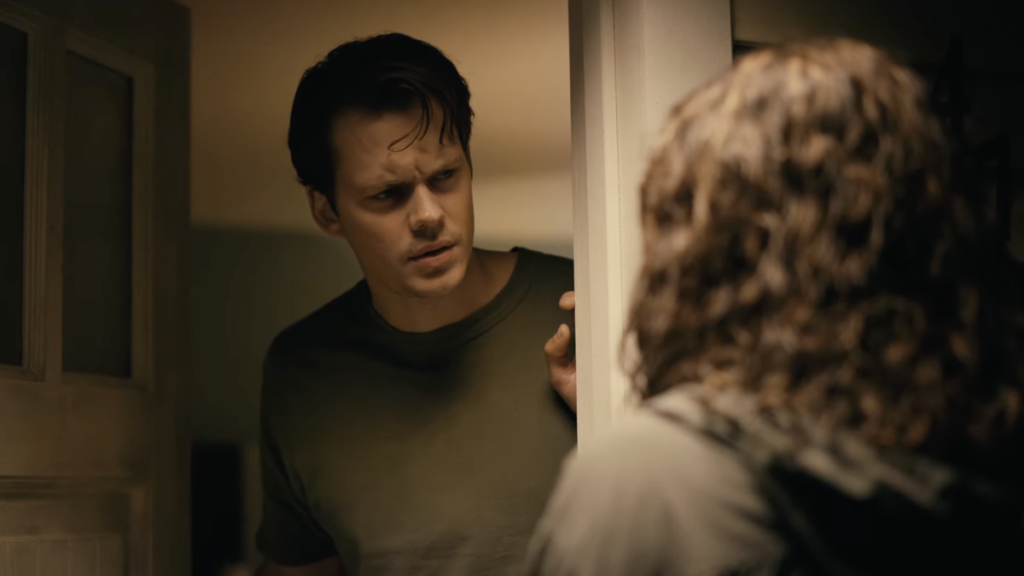
For those who haven’t seen the film, a young woman, Tess, comes to stay at an AirBnB in a poor Detroit suburb while in town for a job interview. But when she gets there, late at night, it turns out a guy, Keith, who says he rented the small home from a separate online rental service, is already there. It’s late. It’s raining. Keith says there’s a convention in town and all the local hotels are full. She might as well stay the night.
What follows is 25 minutes of us wondering if Keith is a bad guy and if he’s set this all up to trap Tess here so he can do God knows what. I suggest you watch the movie yourself before you keep reading this post (it’s free on HBO Max) because I have to get into spoilers. But what happens is, Tess eventually finds a secret room in the basement and both her and a highly suspicious Keith investigate it together. Then something horrid comes out of the shadows and slams Keith’s head against the rock wall repeatedly until his skull cracks.
Before we continue, I’m going to give you the secret to writing great horror.
This is the golden rule that will make you gobs of money if you can perfect it.
All great horror is, is a series of moments where you, the writer, imply something bad is coming, and then milk the suspense until that bad (or, if you want to twist it, un-bad) moment arrives. That is the first act of Barbarian in a nutshell and why it’s so brilliant.
We’re suspicious of Keith right away. Did he really rent this place? Or was he laying in wait? Is he really as good of a guy as he seems? Or is he secretly a monster? You see, once you set that potentially dangerous outcome up, you’ve got the reader on the fishing line. They are all yours.
From there, all you have to do is play with the situation (milk it for everything it’s worth!). So there’s a moment where Keith says, “I’m making tea. Do you want some?” We’ve all seen horror movies before. When a guy is making a drink for a girl, is he really just making her a drink? So you can play with that thread. Is Tess going to drink the tea? As it turns out, she doesn’t drink the tea, which is great, because it means they can suspend the situation even longer.
When you imply a terrible outcome is coming (Tess might be killed), good writers can string that along for five, ten, fifteen, and, in this case, 25 minutes. That’s the secret to writing good horror. You now know what you have to do: set up a potentially bad outcome and milk it. But you still need to practice how to extend the suspense out. Cause if you don’t know what you’re doing, you might invent a lot of silly unbelievable situations that break the magic.
What was so great about Barbarian was that all the suspense was built around real believable situations. Tess wakes up in the middle of the night to find her locked bedroom door open and Keith is on the couch having a nightmare, talking in his sleep. He couldn’t have opened the door. And even if he had, why draw suspicion to himself with the nightmare sleep-talk? So we’re really curious about where this is going.
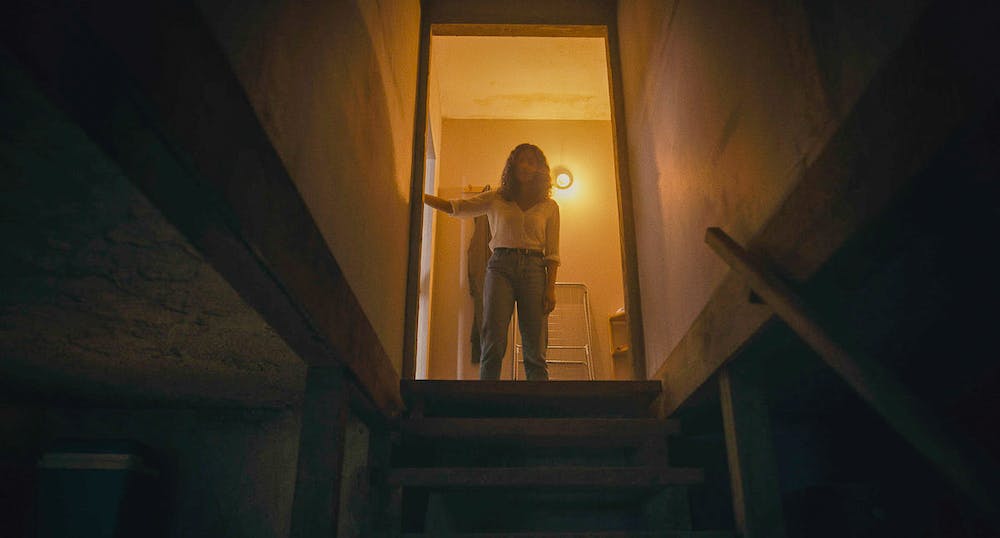
However, once that first act ends, we jump into an entirely different story.
We cut to the Pacific Coast Highway where actor, AJ, gets a phone call from his agents telling him that he’s being accused of rape by his co-star. In other words, we go from a movie that’s entirely about horror and nothing else to straight social-commentary with a fair amount of focus on character development. It becomes the prototypical 2022 modern horror film.
So, the obvious question needs to be asked.
Did it become better or worse when it shifted from classic horror to modern horror?
I argue that once we cross that bridge, the movie loses something.
Now, to be fair, we’re so invested in this spooky house, which AJ finds himself in, that we’re still engaged in the movie. But I couldn’t help but notice that before AJ hit the screen, I’d forgotten I was watching a movie. I really did. And when he and his storyline entered the movie, I became very aware that I was watching a movie. I also became aware that Hollywood was preaching to me.
So what does this mean? Does this mean don’t write modern social commentary character-driven horror? Of course not. Modern horror is what’s selling! So I’m not going to tell you to avoid it. But I do think the audience has caught up to Hollywood. Because of this, they’re more likely to be pulled out of the movie when you preach to them. Whereas, if all you care about is scaring people, and you do what I told you to do above (imply danger is coming and milk it for everything it’s worth), you’re much more likely to write a horror film that everybody loves.
I haven’t seen Smile yet so maybe someone can tell me if there’s a social commentary angle or not. But certainly from the way they’re promoting it, it seems like it’s a movie that just wants to scare you. And how’s that working out for Smile? Oh yeah, it’s just the biggest horror success story in the past four years. That’s the audience telling you something.
But look, if you have a story to tell that you feel passionate about and the themes in it cover any issue (social or otherwise), you can still write a great horror script. It just has to be genuine and not pandering. If you want to know what “pandering” means, look at “They/Them.” That movie was so desperate to push a message that everyone hated it, even the core group it was targeted to. There are no teams when it comes to being annoyingly pandered to.
So don’t write a movie just to appease what Hollywood wants, whether it’s yesterday’s trend, today’s trend, or tomorrow’s. Write a movie that you would write regardless of if the trend existed. Cause when you’re passionate about an idea, that’s worth something on the page. Promising Young Woman was social commentary but you could tell that it wasn’t pandering. Emerald needed to tell that story no matter what.
It’s so funny that a single movie would come out that shows you, via a direct comparison, how true horror and modern horror compare. Who won? You decide.
And guess what? I have a treat for you guys. You can read the Barbarian script below if you don’t have HBO Max. Make sure to tell me what you think in the comments.
Script link: Barbarian
Do you want a script consultation with Scriptshadow? E-mail me if you’re looking to get feedback on your script. You can check out the consult page here but I also offer pretty much any feedback you need, from a logline to a script synopsis to your first act to your whole script! E-mail me at carsonreeves1@gmail.com and let me help you make your script great!
